Traditionally preppers have been heavily focused on buying and stockpiling gear and supplies in an effort to be prepared for a future SHTF event. More and more preppers today, however, are discovering that growing their own food and raising their own livestock and then preserving that food is also a great way to supplement a stockpile.
Fruit trees are just one more way to add to a stockpile. But, fruit trees are not as simple as buy a tree and plant it. It’s important to choose the right fruit trees for your needs and your climate.
To do that, you need to understand the needs of each type of tree, and all the benefits each can provide. Read on for everything you need to know to make fruit trees a productive part of your survival garden.
Benefits of Growing Fruit Trees
First of all when you think about fruit trees, the benefits include:
- No need to replant every year
- Fruit trees grow well in variety of soil types and climates
- Harvested fruit can be used fresh, home canned, or dehydrated for long term storage
- Typically very little maintenance required once trees have fruited
- Fruit has tons of health benefits for preppers depending on the trees you plant.
- Fruit trees can be an ongoing source of needed vitamins and minerals in a SHTF situation.
How to Choose Your Fruit Trees
We’re all familiar with fruit trees, primarily for their delicious tasting fruit. When it comes to prepping, probably the fruit everyone is most aware has multiple uses are apple trees.
Apple trees have a long history of being a source of food on farms and homestead. Fresh baked apple pies, an apple for the teacher, homemade apple cider, and even those delicious dehydrated apple chips have become mainstream.
So if you’re trying to choose fruit trees, here’s what to think about:
- Where it Grows
- How and When to Harvest
- Uses and Benefits
- Pollination Requirements
Where it Grows
Does the fruit tree you’re considering do well in your local area or region? Is it hardy enough to withstand winter weather or the amount of rainfall you get or don’t get in your area?
Analyze the type of soil you have in different areas on your property to make sure that you have the right type of soil for the fruit trees you are considering. Pay attention to which areas of your property get the most sun or have the most shade and which areas seem to be more wet or swampy than others.
Do you have enough space for the number of trees you need to accommodate cross pollination requirements? For those with limited space, consider dwarf (10 to 15 feet) or semi dwarf (10 to 15 feet) fruit trees.
If you are truly limited for space and looking for container fruit trees, genetic dwarf trees which grow only 5 to 7 feet and require less of cold snap are better. Plant your orchard in an open space, away from other trees that might shade your fruit trees or syphon vital water and nutrients.
Ask your nurseryman for recommendations for fruit trees and listen to his advice. Taking the time to learn about your property will help you to choose fruit trees that will thrive and flourish on your property and become a vital part of your long term prepper planning.
How and When to Harvest
It’s important to know how and when to harvest your fruit trees so that you can ensure you get the highest yield from your trees. You also need to be able to plan ahead.
Many fruit trees will take several years to mature and start to produce fruit. It’s important to know this in advance so you can properly plan at what point you can rely on the fruit as part of your stockpile.
To keep your fruit trees healthy enough to make it to harvest time, make sure you plan ahead to protect your trees during spring frosts. Pay attention to disease and pests, and annual pruning requirements.
Uses and Benefits of Fruit Trees
Some fruit trees will provide shade, some will attract more wildlife to your property, which can be a huge benefit if SHTF.
Many fruit trees have medicinal properties, can provide wood for heat or for smoking meat. Still other fruit trees can double as a perimeter deterrent or provide wood for your fireplace or for furniture if their fruiting days are done.
When SHTF, there will be no pharmacies, few stores still operating, if any at all. You may have to survive for an extended period with only what you have on your property. Choose the fruit trees that will give you the greatest flexibility if that day comes.
Pollination Requirements
If you’re going to grow fruit trees, you need to learn about pollination, which is basically the birds and bees (sexual reproduction) for trees. For some trees this means bees do get involved in the process, so plant at least one other fruit tree nearby. Self pollinating trees do not need to be planted near other fruit trees to pollinate.
Peach trees, nectarines, sour cherry trees and apricot trees are in the self pollinating category If you have limited space these might be good trees to choose.
Many types of fruit trees require a pollinator such as sweet cherry, apples, plums and pears. These fruit trees should ideally be planted around 50 feet from another fruit tree that blooms at the same time of the year.
Most fruit trees will do better with cross pollination so keep this in mind when determining how many fruit trees and which varieties you will grow.
Types of Fruit Trees
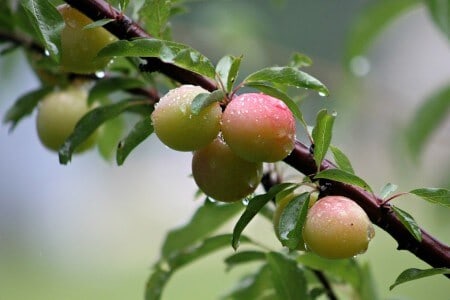
Wild Plum Trees
Where Wild Plum Trees Grow:
- There is a variety of wild plum native to just about every area or region throughout the U.S., Canada, and Europe.
- Ideally wild plums like full sunlight with a drier soil. Too much moisture in the soil can cause the plum tree to rot.
How to Harvest:
- Fruit size, flavor, and texture can vary widely
- Pick when reddish in color
- Domestic plums have 2-4 week harvest window
- Wild plums can ripen for 2-3 months
Uses and Benefits of Wild Plum Tree:
- Not always good fresh from tree
- Better for juice or jelly; requires added sweeteners
- Can be fed in small amounts as fodder
- Some are thorny and can be used as living perimeter fencing
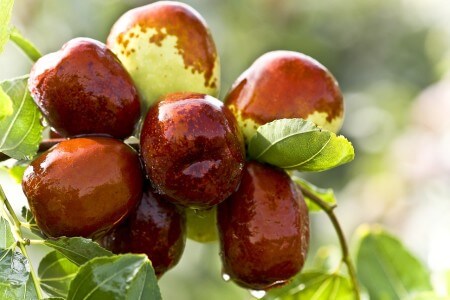
Jujube Trees
The Jujube tree is native to China and is also known as a Chinese date or red date. When picked fresh from the tree it has a taste that is crisp and sweet, similar to some varieties of apples.
Where it Grows:
- In North America, the Jujube tree is typically found in the Southern states.
- Needs a long growing season and dry hot weather to ripen.
- Likes full sun and well drained soil that is neutral or slightly alkaline.
- Very resilient tree, can tolerate cold weather to -20 degrees Fahrenheit or extremely hot temperatures.
- No need to cross pollinate so you can plant just one tree.
- Regular watering ensures fruit quality but tree is drought tolerant
How to Harvest:
- Jujube fruit ripens non-simultaneously so you can pick fruit from the same tree for several weeks.
- Do not pick while green as they will not continue to ripen once picked
- Best time to pick is when fruit is yellowish green and turning to red. Can be picked and eaten once it wrinkles but taste changes.
- Self pollinating but produces better with cross-pollination
Uses and Benefits of Jujube Tree
- Can be made into tea, preserves, vinegar, or wine
- Eat fresh, dehydrate (stores indefinitely), or can be candied.
- Fruit is high in Vitamin C and contains a variety of essential nutrients including iron, potassium, calcium, zinc, and phosphorous
- Has immune boosting medicinal properties. Extracts have been used to relieve pain of sunburn and to soothe dry skin. Fruit has been used to regulate blood circulation and blood pressure. Sedative properties traditionally in Chinese medicine to treat insomnia and anxiety.
- Tree can double as a thorny deterrent to outsiders
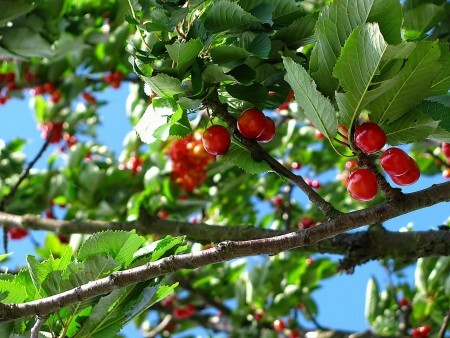
Cherry Trees
Where It Grows:
- Sweet cherry trees are typically found in the Northwestern United States, and other hardiness zones 5 through 7. Sour cherries are smaller and grow in zones 4 through 6. Cherry trees need some cold weather in order to set a high amount of fruit.
- Sweet cherry trees pollinate each other so you’ll need to buy two or three.
- Plant late fall or early spring
- Sunny area with good breeze circulation is best, avoid planting near buildings that could shade your tree.
How to Harvest:
- Pick when fully ripened (color will vary depending on type of tree)
- Cut stem with scissors to avoid injuring fruit
- Eat or dehydrate quickly
- If cherries are to be frozen harvest when still firm
- May not bear fruit until 4th year
Uses and Benefits of Cherry Trees:
- Wine, jam, jelly, pies
- Wood can be used for furniture or for smoking meat
- Cherries are known to treat gout
- The bark and root of the North American wild cherry tree has sedative properties and can be used as a cough suppressant.
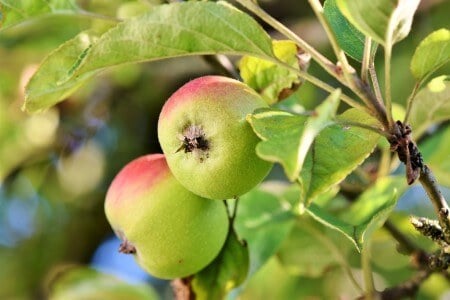
Apple Trees
Where Apple Trees Grow:
- There are over 7,000 apple varieties growing around the world and approximately 100 of these are commercially grown in the U.S.
- Apple trees do well in all temperate zones but ideally should have cold winter to set fruit.
- Apple trees prefer well drained sandy loams and soils but can grow in medium density clays or gravelly sands.
- Most apple trees require a pollinator. There are some self pollinating apple trees but in most cases cross pollinating (at least two different variety of apples) will yield the most fruit.
How to Harvest:
- Apple trees from seedling can take several years to fruit the first time depending on the variety and growing conditions.
- Pick apples when mature while flesh is still hard for best long term storage. It’s also better to keep stems intact if you’re going to store your apples.
- Maturing of apples can vary depending on the variety and the growing conditions.
- Be sure to remove any damaged apples to prevent them from spoiling the rest of the apples during storage. Smaller apples will store longer than larger ones.
Uses and Benefits of Apple Trees:
- Great for pies, juice, cider, and jellies
- Can eat fresh, home can, or dehydrate for long term storage
- Apple trees have medicinal properties. Apple bark can treat diarrhea and fever. Stewed apples treat constipation and baked apples can soothe a sore throat. Apple cider can prevent harmful bacteria growth in intestines.
- Apple peels can be used to purify water
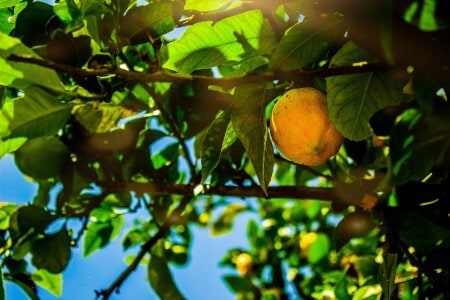
Citrus Trees
The fruit trees in the citrus family include lemons, limes, oranges, bitter orange, blood orange, kumquats, and grapefruit. Although they cannot be grown in every climate, if you are lucky enough to be in the right area, these can be a great addition to your prepper garden.
Where Citrus Trees Grow:
- Zones 9 through 11
- Full sun although some can tolerate a bit of shade
- Typically self pollinating
How to Harvest:
- Can take 6 to 8 months to ripen
- Will not continue to ripen off the tree
- Hand pick when ripe (no longer green) using pruning shears
- Best indicator of ripeness is taste
- Harvest lower branches first
Uses and Benefits of Citrus Fruits:
- Great for preserves, especially marmalade
- Source of Vitamin C and other nutrients
- Thorny trees can double as a privacy screen or hedge
- Leaves and bark can have medicinal properties. Lime flower infusion relieves stress and anxiety. Oranges and leaves used for skin health, as mild diuretic, or as laxative. Lemon leaves and bark used to treat liver cleansing, high blood pressure, and to stop vomiting.
- Citrus oils, lemon and orange are great for natural cleaning products
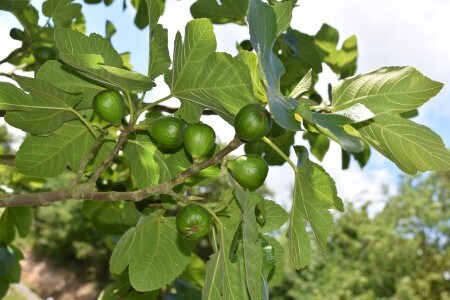
Fig Trees
Where Fig Trees Grow:
- Will do well in Zones 6-10 (not good for Northern U.S. States)
- Be sure to buy a self pollinating cultivar and not one that requires pollination by Mediterranean flies.
When/How to Harvest:
- Will take 4-5 years to bear fruit
Benefits or Uses for Fig Trees:
- One of the types of trees early American settlers carried with them to their new home.
- Plant fig trees in or around your chicken coop. Chickens love to eat the fallen figs and the tree will provide them with shade from the hot sun.
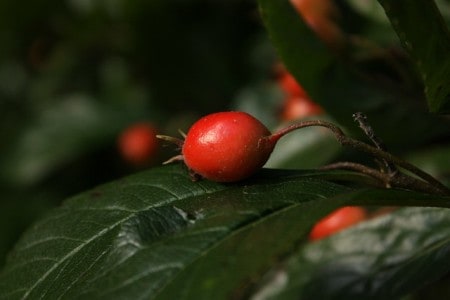
Mayhaws
Where it Grows:
- Does well in zones 3-9
- Believed to self pollinate
- May find growing wild in Louisiana swamplands
- Can find growing wild along creeks
- Does well in well drained, moist soil
How and When to Harvest Mayhaws:
- Fruit ripens late April into May
- Harvest by tarping the ground under tree and then shaking tree
Uses or Benefits of Planting Mayhaws:
- Makes good jelly, syrup, jams, juice
- Berries are high in antioxidants; good for your heart
- Known to lower cholesterol and blood pressure
- Wildlife such as deer, turkey, and wood duck like to graze on these
- In their early growth stages mayhaws make great cover for turkey and deer
- Can attract wildlife to your homestead and increase your access to fresh game
- Thorny tips and branches which can work as a deterrent to keep people from harvesting your food or as a living perimeter fence.

Kieffer Pear
Where it Grows:
- USDA zones 4 through 9
- No pollination required for Kieffer pear, but does better cross pollinated
- Other pear trees require trees of other varieties to pollinate
- Plant in full sun in well drained soil
How to Harvest Pears:
- Fruit ripens October to November
- Pick when firm with yellow-green color, let ripen off tree
Uses or Benefits of Planting Pears:
- Good source of vitamin C, fiber, and potassium
- Can be eaten fresh, made into jelly, canned, or stored in root cellars
- Not susceptible to fireblight like other pear varieties
- Use pear tree wood for carving and for meat smoking
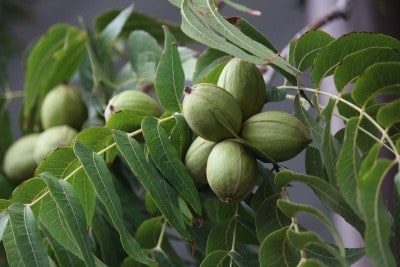
Pecan Trees
The pecan tree is a member of the hickory genus. Even though most people think of pecans as a nut, they are actually a fruit with a pit encased in a husk. The part we know as the nut contains the seed.
Pecan trees are wind pollinated, which means they are dependent on bees for pollination. They are also monecious, the male and female flowers are on the same tree.
Where it Grows:
- Plant December to February
- Fully mature trees pull a lot of moisture from ground (more than 150 gallons a day)
- Will require irrigation during the winter months
- Full sun in a minimum of 36 inches of well drained soil
How to Harvest:
- Plant in advance of need, takes 5 to 7 years to bear fruit
- Grafted trees may produce within 3 or 4 years
- Harvest in late fall
Uses and Benefits of Pecans
- Great for pies
- Could be great for bartering
- Will store for months if kept dry
- No cooking needed
- Source for Vitamin B-6, fiber, magnesium, iron
Did we include your favorite fruit tree on our list? Let us know what fruit trees you plan to grow, or have growing in your garden in the comments below.
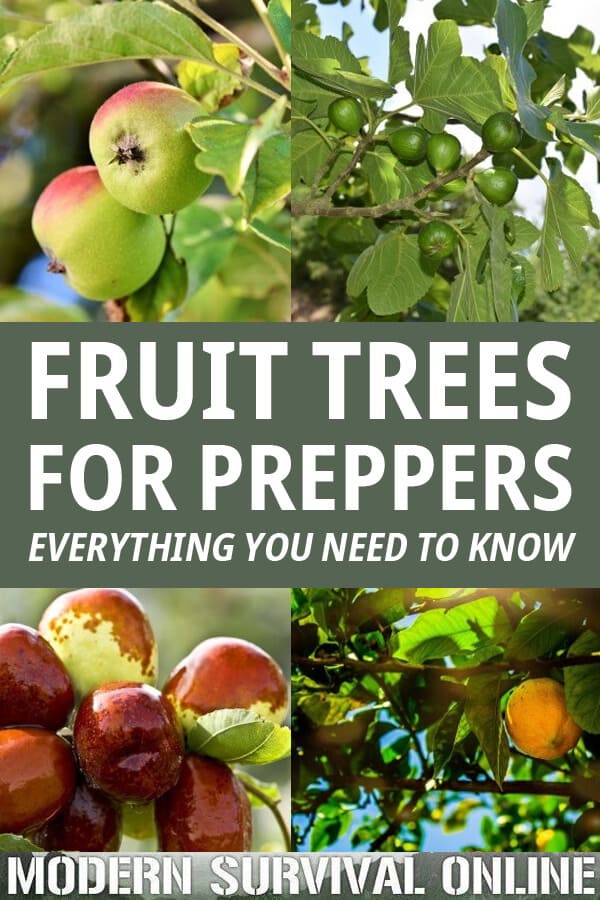

Like what you read?
Then you're gonna love my free PDF, 20 common survival items, 20 uncommon survival uses for each. That's 400 total uses for these dirt-cheap little items!
We will not spam you.
all good to know